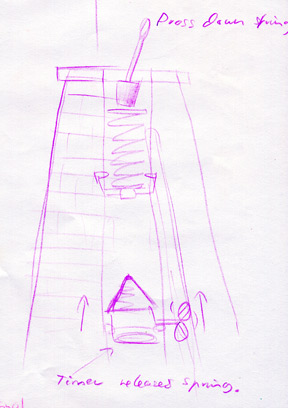|
Game Inventor workshop on Persuasion
No matter how many great ideas you come up with unless you can relay it in the most effective way, some ideas may not make it. I have, and do come up with about 50 or more ideas a year and up to 100 if I really try, but how well l present and explain the ideas is crucial to achieving the highest possible strike rate. "I usually have more than 10 ideas a year that have a chance". There are two brothers who developed Imaginiff and Moods two very successful board games in the same year (and l have recently heard that they developed Faces, in the same year as the two mentioned above)! These two brothers have the same number and quality of ideas that most people do, but one of the reasons they have a higher strike rate is because they presented their ideas more strongly or enthusiastically. These two brothers are what you would call “Extrovert”, or having a more outgoing personality. And as l am recently finding out myself, after visiting Blue Opal with 7 ideas and almost getting all the ideas accepted, (will be worth sending off to Toy Companies if it can be turned into a working game) that the 2 brothers probably used the "law of attraction" as well to achieve this remarkable strike rate! The law of attraction chapter is in the Money Puzzle ebook offer on this site! I tend to develop an idea one-dimensionally then move on. One -dimensionally is one concept of an idea, rather than 2, 3 or as many as possible. Also if the person l am seeing ums and arrs about an idea l may move on hoping that the next idea makes the grade, rather than pushing the concept as hard as possible. It is really up to you how you structure your ideas; sometimes it can be a puzzle within itself to know whether a concept has a winning aspect to it, which is why programming your Subconscious (as discussed on the previous page) is so important. But after reading this,(including this Toy and Game Inventor workshop page) you should be able to stay in the board game, puzzle “sweet spot” and have the greatest possible chance of one or more successes per year. If you are an extrovert then you will have a greater chance than someone who isn't, like me. But the rest of us can still use techniques to increase our chances. The first thing is most people think in a certain way, either Audio, Visual or Kinaesthetic. Audio is thinking by talking to yourself, Visual is seeing something and Kinaesthetic is feeling it. So an example of Audio is hearing a Puppy yelp, Visual is seeing the Puppy and Kinaesthetic is patting the Puppy and feeling its soft hair. We use the other two modes as well, but we tend to use one the most. So unless you can pick which mode the person you are seeing is using, it is best to stay with all three to be as persuasive as possible and to be sure the person fully understands what you are trying to convey. An example of this is the person you are trying to convey a concept to says I see, then they may be thinking in a Visual way and using Visual words to describe your ideas to them would be a clearer and more effective means to communicate to them. Audio, they may say, sounds like a great idea or l hear what you are saying and Kinaesthetic they may say l am getting a vibe on what you are saying or that feels good, etc. So now you can understand why some people you talk to have trouble understanding what you are saying, its not that they are not smart, it's just that they may be seeing what you are trying to convey verbally, or verbally describing what you feel about your idea. Confusing but true. So when seeing someone you could describe how it looks, what noises it makes and how the playing pieces feel. Napoleon Hills, “Talk and grow Rich” covers these concepts in more detail and l am just giving an overview of techniques that will help when presenting your ideas. Even after 7 years experience l still get tunnel vision (cannot see the woods for the trees) mindset. So using your friends and family as a sounding board is a great way to figure out how to make an ok idea great and figure out which ideas are great and which are not (although as said before you should show all ideas). When l see David and we are trying to figure out a concept his wife and kids may get involved and offer a detached point of view. Obviously getting a group of friends to throw some ideas around is a fun way of developing something viable, but make sure that they read this first to make the group as efficient as possible.
Well! you are all finished with the Toy and Game Inventor workshop page, please click on the next one when ready. |


